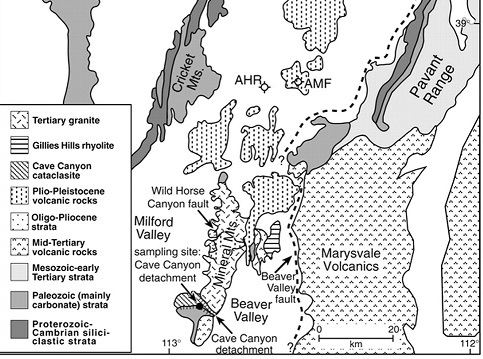Dublin Core
Title
Description
A pre-historic obsidian quarry in western Utah was used for thousands of years to manufacture razor sharp tools and weapons.
Overlooking the west desert in Beaver County’s Mineral Mountains is Wildhorse Canyon, a remote, dry, scrappy place that houses one of the most important pre-historic obsidian quarries in the Great Basin.
Obsidian is a naturally occurring volcanic glass used by ancient people to manufacture razor sharp tools such as projectile points and blades. Sources of obsidian are few, so the precious material was valued highly and traded widely across the Americas. Archaeologists can determine through chemical analysis not only the age of obsidian artifacts, but also their origin from specific quarries. In this way, ancient travel and trade routes can be traced.
Archaeological studies at Wildhorse Canyon suggest that the site served as a major obsidian quarry and tool manufacturing station for this part of the Great Basin. The work of breaking and shaping the stone was performed at or near the quarry, and the finished – or nearly finished – products were then transported to users throughout Central Utah and beyond.
Fifty miles south of the Mineral Mountains are the remains of four Fremont Indian villages, which were active for about 400 years between 900 and 1300 A.D. Archaeological exploration of these villages has uncovered artifacts made of three types of obsidian, all of which come from the Wildhorse Canyon quarry. No other quarry with these three types of obsidian has been discovered in Utah.
The quarry at Wildhorse Canyon was a source of both raw obsidian and finished obsidian goods for a much larger area and a much longer time span than represented by the Fremont villages. The vast quantity of debris found at the Wildhorse Canyon site indicates much more than a few generations of use. Indeed, evidence from the quarry and from other pre-historic sites excavated in the Great Basin indicate that Wildhorse Canyon served as western Utah's major obsidian quarry for several thousand years.
Creator
Source
Image: Geological map of the central Utah. Mineral Mountains, where the Wildhorse Canyon obsidian quarry was, is featured and denoted as a site containing mid-tertiary volcanic rocks. Courtesy of the Geological Society of America.
_______________
See Becky Bartholomew, “Wildhorse Canyon Supplied Obsidian For Use,” History Blazer, June 1996, accessed via http://historytogo.utah.gov; Wildhorse Canyon Obsidian Quarry Nomination Form, National Register of Historic Places, Preservation Office files, Utah Division of State History; Michael S. Berry, The Evans Site (Salt Lake City: Department of Anthropology, University of Utah Special Report, 1972); and George T. Jones, Charlotte Beck, Eric E. Jones, Richard E. Hughes, “Lithic Source Use and Paleoarchaic Foraging Territories in the Great Basin,” American Antiquity, Vol. 68, No. 1 (Jan., 2003), pp. 5-38.

